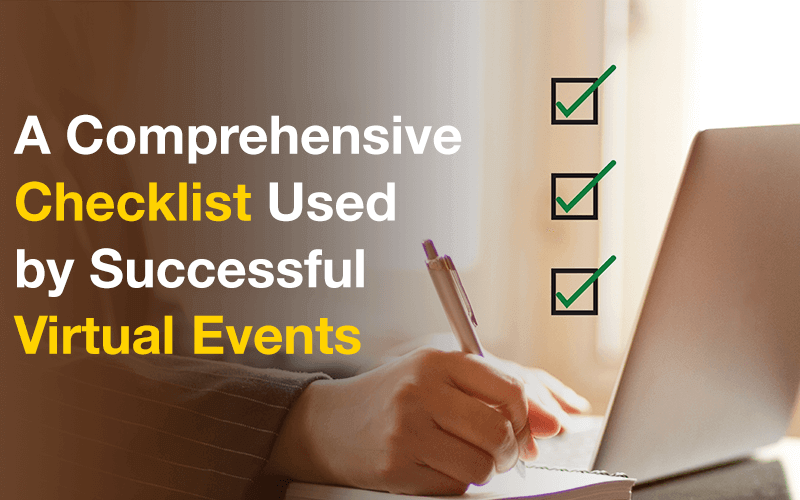
Something feels like it’s missing.
You’ve rounded up all the contacts you need, made a list of online event solutions to research, and you’ve checked in with multiple team members before moving forward. But what if you forgot to include a crucial aspect on your virtual event checklist?
Many event organizers shared these concerns with us during the process of planning a virtual event. Maintaining an effective event project management process has never been easy, and for many event planners, the shift to virtual events has re-ignited this stress of staying organized. We’ve received a surprising amount of requests from event organizers for a detailed list of things to do to prepare for the transition. Most of these organizers had never organized a virtual event before, and they didn’t want to miss a single important factor in the new virtual event planning process.
Even with a couple of virtual events under your belt, it’s still so important to have a detailed, comprehensive checklist to make sure you don’t miss any critical virtual event components. We’ve created this virtual event planning checklist so they can make sure that their event is just as successful as an in-person event.
How could we create a virtual event checklist that would help every type of event go virtual?
Since virtual event planning is relatively new, there are limited resources we can use to create the list. More importantly, every event is different, some with 100 attendees, while others have 500 or more than 1000 attendees. Some of these events have only local participants, while others have participants all around the world. Some of the events are conferences with breakout sessions and lots of speakers, while others are expos that focus more on the exhibitors. You get the idea.
Fortunately, throughout the past several months, Whova has worked with over 6,000 virtual events of various types and accumulated a lot of experience. We’ve also contacted the organizers of all different types of events to ask for the lessons they’ve learned. With all this information, we were able to compile a comprehensive list of 57 items that cover the details of organizing a virtual event of any type, from selecting the best event registration platforms to ensuring a smooth and engaging experience for all attendees.
Structure of the checklist
We divided the virtual conference checklist into 3 major sections:
- Before the event
- During the event
- After the event
In each section, we cover different categories. For example, in the first section, we cover how to choose software/hardware platforms, how to communicate with the participants, what to consider in registration, and more.
In the second section, we include items related to managing session streaming, how to advocate for your sponsors and exhibitors, and more. In the final section, we describe how to follow up with participants and other considerations for after the event ends.
Here’s a sample of what you’ll see in the virtual event planning checklist:
Before the event day
1. Choose to livestream, pre-record videos, or a use a hybrid of the two according to the event’s needs
Remember to take this into account when deciding which software to use. Consider how these formats might suit your event, and whether potential platforms can support them.
2. Decide if the event should be extended a few more days
Consider a structure that helps attendees avoid Zoom fatigue! Virtual attendees often focus better with shorter days spread out across a longer period.
3. Decide whether to make all content public, or restrict to registrants only
Weigh the benefits of potentially keeping some content private and more secure versus making your brand accessible to more people for your event.
4. If attendees span over a large geographic area, consider recording sessions and allow on-demand replay
Try to accommodate different time zones. If more people will be in a specific location, you can also consider holding engagement/networking opportunities for those groups.
Editor’s note: This is one of the most important items in our virtual event planning checklist. Attendees often request recordings.
5. Choose a streaming software platform (e.g. Zoom, WebEx)
Consider what you need for your event, such as the number of attendees and concurrent sessions, and make sure the software integrates with the platform you plan on using.
6. Choose an attendee interaction software.
Depending on your event’s needs, you might consider choosing a platform that integrates interaction with the rest of the event such as Whova, or a chat-only solution such as Slack.
7. Select miscellaneous tools
Find services to support your event’s other needs like an emailing service (e.g. Mailchimp), caption generation, and interpreter services if needed.
8. Decide if you need high-quality A/V devices, such as recording devices to filter noise/echo
Bigger events with high production value may want to ensure high-quality audio, but for other, smaller events this will likely be less important.
9. Plan social interaction activities
Having a concrete plan for the social interaction and gamification at your event is even more important when you go virtual. It’s important to keep your remote attendees engaged, and able to connect with other participants. With some virtual conference platforms, you can set up activities prior to the event date to get your audience connected and excited. Check out some ideas for pre-event virtual conference activities here: https://whova.com/blog/5-pre-event-activities-spice-up-virtual-conference/
10. Create a participant guide for watching sessions and interacting with other attendees, and send it with the event timeline.
Participants may need some guidance getting the most out of using unfamiliar platforms. See if the platform has attendee guides, and if not, develop your own.
Editor’s note: It might sound trivial but a guide can save you time answering your attendees’s questions. A highly recommended step in our virtual event checklist.
11. Create a speaker or panelist guide on pre-recording or live streaming presentations
Ensure things go smoothly on the speaker side, and help out potentially less tech-savvy presenters. You also check with the event platform to see if they have resources on hand. You can find Whova’s speaker guide here.
12. Create a sponsor or exhibitor guide on effectively interacting with participants to achieve their ROI goals
Make sure they know how to use the platform to get the strongest benefits and ROI possible out of the event. Here is an example of exhibitor guide and sponsor guide.
13. Choose your online registration platform and decide on a ticket price for your virtual event
Deciding how to set the price of a ticket to a virtual event will take some thought. Know your audience, and come up with a pricing model that matches your attendees expectations for a virtual conference.
Choosing an online registration platform with lower fees can be a great way to cut the ticket cost.
14. On the registration form, collect the registrant’s time zone information and accessibility requirements
For a virtual event, it’s important to know where all of your attendees will be participating from, as well as any accessibility information that needs to be accommodated for. Depending on form responses, you may need to adjust your event schedule, or make video recordings available to those in far away time zones.
……
Request Full Checklist of 57 Items
During the event
15. Start every session 15 minutes earlier to check the device and network
Take a little extra time to make sure everything is ready for the session. Have the speaker join the session early to ensure that everything is good to go.
16. Prepare for and react to any disruption
This can range from moderating inappropriate content to dealing with last-minute technical issues. To help yourself prepare, try referring to Whova’s Emergency Guide.
17. Record live sessions to share with participants later
Some of your online participants may have to miss certain sessions, or might be interested in multiple sessions happening at the same. It’s a good idea to record all of your live sessions so you have the option to share or upload them to your virtual event platform later.
18. Collect and moderate online Q&A
In addition to removing offensive content, be prepared to choose askers, pin questions to the top, and remove redundant questions. Have someone besides the speaker/panelist on hand to manage Q&A.
19. Coordinate online gamification such as a photo contest
Encourage interaction with some friendly competition! Gamification like Whova’s photo contest can help attendees get more involved while competing for a prize.
20. Start virtual meet-ups
While you can’t meet in-person, make sure to give attendees the chance online. Setting up virtual video meet-ups can be a great way to get to know each other “face-to-face.”
21. Organize online discussions
Encourage engagement and get attendees talking by bringing relevant discussion topics through a tool like Whova’s Community Board or a separate app like Slack.
22. Share articles and videos
Spark conversations further by sharing resources, whether they’re useful, interesting, or just fun, through these discussion channels. This can also be a great way to promote speakers and sponsors’ content!
……
Request Full Virtual Event Checklist of 57 Items
After the Event
23. Cancel your monthly streaming software subscription
Once the event is over, make sure you’re not still paying for a streaming subscription, mailing service, or anything else you don’t need to use anymore!
Editor’s note: This is one of the easiest items to forget in our virtual event planning checklist. Make sure to set a calendar reminder.
24. Look for a storage service to store the archived videos
If there’s any content you’d like to save, don’t just leave it in the virtual event. Keep pre-recorded videos and session recordings safely stored for you to access later.
25. Send attendee surveys to collect their feedback for the virtual experience
Feedback can be a valuable tool in making sure your next event is even better! Some event platforms, such as Whova can provide customizable surveys to make it even easier to send these out.
26. Check in with speakers, volunteers, and moderators and express your gratitude for their efforts in this special event
Not only is it good manners, but making sure they know their efforts were appreciated can make them more likely to participate in the future!
27. Follow up with sponsors and exhibitors to thank them for their support during the tough time, and see if they reached their goal
Ask what worked for them, what they’d like to see improved in the future, and if they feel happy with the results. You can use this information to make sure they get even better ROI in the future.
28. Send out the prizes for online gamification
Remember to send out any prizes, or if they aren’t immediately available, follow up with the winners on when they’ll be sent.
29. Generate a report of the event to check the total participants, activities, and feedback.
Prepare for next year with a comprehensive overview of the event, and compare with previous in-person events. Some event platforms, like Whova, will automatically generate the report for you.
If you’d like to get a downloadable copy of the complete virtual event planning checklist of 57 items, please contact your Whova account manager or request a live demo so our event consultant will share our virtual conference checklist with you after the demo.
